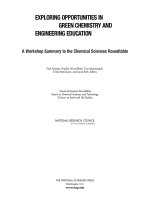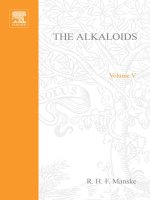Chemistry and chemicals
Bạn đang xem bản rút gọn của tài liệu. Xem và tải ngay bản đầy đủ của tài liệu tại đây (2.22 MB, 44 trang )
Chemistry in Our Lives
Chemistry and Chemicals
What is chemistry?
Chemistry is the study of substances in terms of
Composition
What a material it made of
Structure
How the elementary particles are put together
Properties
The characteristics of the material
Reactions
How it behave with other substances
Chemical reactions happen when
• a car is started
• tarnish is removed from silver
• fertilizer is added to help plants
grow
• food is digested
• electricity is produced from
burning natural gas
• rust is formed on iron nails
Everything in our lives from materials
to life involve chemistry
•
•
•
•
•
•
•
•
glass (SiO2)n
metal alloys
chemically treated water
plastics and polymers
baking soda, NaHCO3
foods
fertilizers and pesticides
living beings
Chemicals in Toothpaste
The Scientific Method
The scientific method is the
process used to explain
observations in nature.
The method involves:
• making observations
• forming a hypothesis
• doing experiments to test
the hypothesis
Everyday Scientific Thinking
• Observation: The sound from a CD in a CD
player skips.
• Hypothesis 1: The CD or player is faulty.
• Experiment 1: When the CD is replaced with another
one, the sound from the second CD is
OK.
• Hypothesis 2: The original CD has a defect.
• Experiment 2: When the original CD is played in another
player, the sound still skips.
• Theory:
The experimental results suggest that
the original CD has a defect.
Units of Measurement
In chemistry:
quantities are measured
experiments are performed
results are calculated
use numbers to report measurements,
results are compared to standards.
In a measurement of the thickness
of the skin fold at the waist,
calipers are used.
A measuring tool is used to
compare some dimension
of an object to a standard.
In every measurement, a number must be followed by a unit
to have any meaning.
Observe the following examples of measurements:
Number and Unit
35 m (meter)
0.25 L (liter)
225 lb (pound)
3.4 h (hour)
The Metric System (SI)
The metric system and SI (international
system) are
related decimal systems based on 10
used in most of the world
used everywhere by scientists
Length
is measured using a meter stick
uses the unit meter
(m) in both the metric and SI systems
The unit of an inch
is equal to exactly
2.54 centimeters in
the metric system
1 in. = 2.54 cm
Volume
is the space occupied
by a substance
the unit of volume is the
liter (L) in the metric
system
1 L = 1.06 qt
The mass of an object
is a measure of the quantity of material it contains
the unit gram (g) or kilogram (1000 g) is used
What is the difference between mass and weight?
Weight is the result of the action of gravity on mass. Your weight
on the moon would be a lot less even though your mass would
remain the same
Despite this important difference, we will use these two terms interchangeably
The temperature
indicates how hot or cold a
substance is
the Celsius (°C) scale is used
in the metric system
the Kelvin (K) scale is also
used
18 °C is 64 °F on this
thermometer
On the °C scale, the melting point of ice is 0 °C and boiling point of
water is 100 °C
What is heat or cold? What does temperature really measure?
Time measurement
the unit second (s) is
used in the metric
system.
Time is based on an
atomic clock that uses a
frequency emitted by
cesium atoms
Scientific notation
is used to write very large or very small numbers
the width of a human hair (0.000 008 m) is written
8 x 10-6 m
a large number such as 4 500 000 s is written
4.5 x 106 s
Scientific Notation
A number in scientific notation contains a coefficient and a
power of 10.
coefficient
1.5
power of ten
x
102
coefficient
7.35
power of ten
x 10-4
To write a number in scientific notation, the decimal point is
placed after the first digit.
The spaces moved are shown as a power of ten.
52 000. = 5.2 x 104
0.00378 = 3.78 x 10-3
4 spaces left
3 spaces right
10-3/105 =
10-8
10-3*105 =
102
10-3 +105 =
105
100000 + 0.001 = 100000.001
Measurements
What is the length of this piece of wood?
What is the first digit? Any uncertainty in the digit?
What is the second digit? Any uncertainty in this digit?
What is the third digit? Any uncertainty in this digit?
4
4.5
4.56
Definition of a significant figure:
Significant digits include all digits with no uncertainty plus one estimation
• . l8. . . . l . . . . l9. . . . l . . . . l10. . cm
•
•
•
•
What is the length of the red line?
1) 9.38 cm
2) 9.39 cm
3) 9.40 cm
9.38, or 9.39, 9.40 is less likely
Measurement
Number of
Significant
Figures
38.15 cm
4
5.6 ft
2
120.55 m
5
0.0055 in
1200 m
2
2









